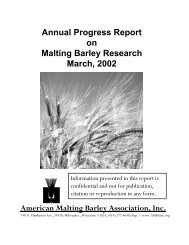Annual Progress Report on Malting Barley Research March, 2007
Annual Progress Report on Malting Barley Research March, 2007
Annual Progress Report on Malting Barley Research March, 2007
You also want an ePaper? Increase the reach of your titles
YUMPU automatically turns print PDFs into web optimized ePapers that Google loves.
oot rot. In collaborati<strong>on</strong> with Scott Halley at the Langd<strong>on</strong> <strong>Research</strong> Extensi<strong>on</strong> Centre we<br />
chose sites expected to have moderate levels of the CRR pathogen due to their history of<br />
c<strong>on</strong>secutive cereal crops. We planted these lines in 4’x10’ plots in Langd<strong>on</strong> <strong>on</strong> unirrigated<br />
and uninoculated plots with 8 replicati<strong>on</strong>s. At hard dough stage plants were randomly<br />
pulled from each plot until we had at least 20 sub-crown internodes 1-2cm l<strong>on</strong>g from each<br />
plot. Sub-crown internodes are being stripped of their papery covering prior to disease<br />
assessment. Approximately 9000 plants were pulled. At maturity plots were harvested and<br />
seed retained for quality assessment. When informati<strong>on</strong> about resistance genes for CRR is<br />
available it will be made available to breeders to incorporate resistance into current<br />
breeding programs.<br />
2. FHB Resistance Gene Mapping for <strong>Barley</strong> CAP<br />
In 2006 we collaborated <strong>on</strong> the first year of a four year project <strong>on</strong> mapping FHB using<br />
associati<strong>on</strong> genetics. This project is funded by the CSREES CAP and led by Kevin Smith,<br />
University of Minnesota. The collaborative trial included 96 entries from each of the four<br />
Midwest breeding programs. We planted two misted and inoculated FHB nurseries (Fargo<br />
and Langd<strong>on</strong> ND) in single row plots, two replicates per locati<strong>on</strong> in an augmented block<br />
design including the checks Robust, Stander, MNBrite, Chevr<strong>on</strong>. Due to extremely hot dry<br />
c<strong>on</strong>diti<strong>on</strong>s at maturity causing premature ripening <strong>on</strong>ly <strong>on</strong>e replicate was able to be<br />
assessed for disease at each site however data <strong>on</strong> DON toxin levels, heading date and<br />
harvest was able to be undertaken <strong>on</strong> both replicates at both sites. The informati<strong>on</strong> about<br />
resistance genes for FHB which is generated in this project will be made available to<br />
breeders to speed up the incorporati<strong>on</strong> of resistance into current breeding programs.<br />
3. Pre-harvest crop management to reduce FHB<br />
The aim of this project is to investigate FHB and DON in barley after use of pre-harvest<br />
desiccant herbicides and swathing to speed-up the maturity of the crop and reduce losses<br />
due to lodging and head shattering.<br />
As Fusarium is both a pathogen and saprophyte and is favored by warm temperatures and<br />
high humidity, the act of swathing a crop could result in an increase in Fusarium levels<br />
during the latter stages of crop maturity. As rainfall during grain ripening and maturity are<br />
variable between years, simulated rainfall is achieved by irrigati<strong>on</strong> of the swath. The<br />
amounts of simulated rainfall quantity and frequency are proporti<strong>on</strong>al to historical rainfall<br />
patterns at each trial site. DON, visual infecti<strong>on</strong> and microbial analyses are d<strong>on</strong>e <strong>on</strong> the<br />
treatments.<br />
Unexpected effects from combinati<strong>on</strong>s of disease and herbicides have been reported for<br />
decades so that the reports <strong>on</strong> herbicide-disease interacti<strong>on</strong>s with FHB and glyphosate<br />
which originated in Canada require critical experimentati<strong>on</strong> to verify their validity. A range of<br />
herbicides registered for use as pre-harvest desiccants were tested over the range of<br />
recommended growth stages. Susceptible and moderately resistant cultivars were tested<br />
under a range of envir<strong>on</strong>mental c<strong>on</strong>diti<strong>on</strong>s. The crop was assessed for DON, visual<br />
infecti<strong>on</strong>, microbial analysis and important; yield and quality comp<strong>on</strong>ents.<br />
69
















